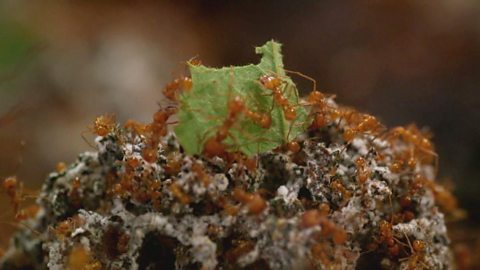ADAM:'This is Planet Ant. A giant, man-made ant home, built especially above ground, to allow us to investigate the incredible lives of these tiny creatures.
ADAM:'These glass boxes and tubes have been built to replicate the underground tunnels and chambers of an ant colony in the wild and they're full of busy leafcutter ants.
ADAM:'This is the first time that a man-made ant colony has been built on this scale.
ADAM:'I've brought some young scientists along to Planet Ant to see what we can discover about one of the world's most fascinating insects. And like all good scientists, they have lots of questions.'
CHILD #1:Adam what are they doing with all the mud?
ADAM:That's a really good question. When they're out here, they're treating this area
ADAM:like it's a place to go and feed so they're probably just getting a bit hungry and trying to carry anything they can find back. One thing they're not doing, is digging down into it to find any new nest space because that all happens back up there, at the colony. So out here, it's all about feeding.
ADAM:'The leafcutter ants on Planet Ant, were collected from South America and carefully transported thousands of miles to the UK where they began organising their new home.
ADAM:'The young scientists wanted to find out more about the ant's habitat for themselves so they collected some ants of their own and now they're ready to build their own mini version of Planet Ant.'
ADAM:What sort of things do you think ants need to be able to live?
CHILD #2:Water?
ADAM:Yeah, water is important, they certainly need a bit of water.
CHILD #3:Food?
ADAM:Food, yeah, food is really important, we all need food.
CHILD #2:Air?
ADAM:Ants need air, just like we do.
ADAM:What do you think the soil is for?
CHILD #4:Keeps them warm?
ADAM:Yeah keeps them warm and it protects them so it's a little bit like living in a house, it protects you from the weather, it keeps you nice and warm and cosy.
ADAM:So what we're gonna try and do, is make a nice, warm, cosy nest for these ants.
ADAM:'First we're using three, large, see through, plastic cups with a little plaster in the bottom. This will hold a bit of water and weight the cups down. Next we're putting a smaller plastic cup inside the big one.
ADAM:We're going to build up a layer of soil around the cup that's in the middle but it will also mean that we'll be able to see them through the outside of the cup. Billy has the fiddly job of putting the soil in the gap between the two cups.'
ADAM:What would happen if you try and pick them up with your fingers?
CHILD #3:Squish them?
ADAM:Yeah, you might squash them.
ADAM:What we can use is this and this is called a pooter and you can make one really easily. It's just a couple of tubes going into a little jar and one of the tubes-- can you see? One of the tubes has got that filter over the end of it.
ADAM:So what you're gonna do is suck on one tube and it's gonna suck the ants up through the other tube. So it's like a little vacuum cleaner. It’s a really, really good way to collect delicate things like ants
ADAM:So should we have a go, at collecting as many as we can from one of these colonies here so that we can put them into our nests?
ADAM:So, you need to get pootering now.
ADAM:'We surround the big cups with water to stop the ants escaping like a moat around a castle.'
ADAM:So we've got our nests set up. The ants can't escape because we've got a moat. What's the next thing we've got to do?
CHILD #3:Put the ants-- Take the ants out and put them in?
ADAM:Yeah, put the ants in. So, one at a time.
ADAM:There you go, you've got a few on the lid.
ADAM:'Once the leafcutter ants have been collected from the wild, they were introduced to their man-made home. We put the ants and some fresh soil onto the top of the nest. This is our ground level.
ADAM:'From here, they made their own way, down into the nest boxes which are like the chambers they build in the wild.
ADAM:'The queen ant is the only ant that lays eggs so she's vital to the colony.
ADAM:'She's put safely in the nest.'
ADAM:Yep, she's in.
ADAM:'Planet ant has two main areas the nest boxes and the foraging table. Our young scientists are gonna replicate this with their own mini Planet Ant.'
ADAM:What else do you think they need?
CHILD #2:Air?
CHILD #3:Food?
ADAM:Yeah food. They've got lots of air, the soil's quite moist so they've got water but we need to give them some food. So now, what does that smell like?
ADAM:'We're giving these ants water with some honey in it.'
CHILD #3:Is that enough?
ADAM:Yeah that's enough. We can check on them every day, just to give them a little bit more food if they need We've got ants in here and we've got food in there so what's our problem?
CHILD #1:How are they gonna get it?
ADAM:Yeah, how are they gonna get from one to the other. So how do you think we might solve that?
CHILD #2:We might need some tubes.
ADAM:Yeah, we can put some tubes in, we can build some bridges.
ADAM:'Once the ants had settled into the nest boxes in the big Planet Ant it was time to let them loose on the wider world we'd built for them.'
ADAM:'This was our first chance to see how they organised their leaf cutting together.'
ADAM:'Zoologist, George McGavin, was there to give me a hand.'
5600:05:21:15 00:05:24:17GEORGE:What we want to do now, is to allow them to forage
GEORGE:in a natural way they would do in their real environment and to do that, we need to join up the colony with the virgin foraging lands beyond.
ADAM:'For the ants, its finally time to explore.'
GEORGE:Well we've only just put the bridge in and already, we've got workers swarming up as far as here so I don't think it'll take very long for them to find the other end of this bridge.
ADAM:'Tentatively, the ants start to make their way down the bridge. Although it's not exactly a massive trail just yet.'
GEORGE:In the wild, you see them foraging all over the ground but how far will they forage from their main nest?
ADAM:Up to 100m sometimes more so you can follow these trails deep into the forest and in fact this colony was foraging deep into a citrus grove and you could follow them back 100m or more.
ADAM:'Our time lapse cameras reveal that the trickle of ants across the bridge quickly becomes a flood. More and more ants head out to explore the foraging areas beyond.
ADAM:'Now we'll have to wait to see how quickly they discover the plants and get their leaf cutting operation underway.
ADAM:'Back at the mini Planet Ant, the young scientists need to help their ants find their food.'
ADAM:OK, shall we try and connect these ants up to their food?
ALL:Yeah.
ADAM:So there's a stick there if you want to connect that side up and lay that one down. So do you want to just plonk that in? There we go.
ADAM:And yeah, we've already got an ant crawling out here. So they're already exploring. We've only made this up for a couple of minutes and we've got ants moving along these bridges. They're really, really good at finding new places finding nests and finding food.
ADAM:'The ants on Planet Ant and the ants in our mini ant colony, now start exploring their new homes.
ADAM:'For our mini ant homes we used three large plastic cups with a bit of plaster in the bottom to hold water and weight them down. We put smaller plastic cups inside two of the bigger ones and filled the gap with soil. These are our mini nest boxes.
ADAM:'We used pooters to collect the ants.
ADAM:'In the third cup, we put some honeyed water to feed the ants. This is our mini foraging table.
ADAM:'Lastly, we connected all the cups up with some twigs. Both these colonies have been given the food, water and shelter that they need to survive.'
The young scientists create their own small ant colony using plastic cups, before being shown how to make and use a pooter to collect the ants.
Meanwhile, the ants from Trinidad are being monitored as they explore their new man-made home.
Entomologist Dr George McGavin uses a ramp to bridge the colony to the foraging area where food is available.
At first, a few ants venture across the ramp and then gradually the ants swarm across the bridge.
In the wild, ants will forage for over 100 metres.
The young scientists use a piece of wood as a bridge between their small colony and some honeyed water, and soon find their ants crossing over to the food source.
This clip is from the series Life on Planet Ant.
Teacher Notes
Students could follow the example and create their own ant colony using plastic cups, soil and pieces of wood.
In order to collect ants for their colony the students could also make a simple pouter using a transparent plastic jar, plastic tubing and gauze or net fabric.
Once they have set up their colony they could carry out observations, keep a diary or notes recording what they see, and compare the behaviour of their colony of ants with the colony in the clip, noting similarities and differences between the two.
Curriculum Notes
This clip will be relevant for teaching Science/Biology at KS2 in England, Wales and Northern Ireland and 2nd Level in Scotland.
More from Life on Planet Ant
Inside an ant colony. video
The most important ant is the queen whose job it is to lay the eggs and there are also many different types of worker ants.
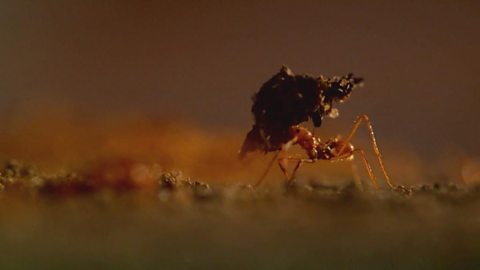
How ants communicate. video
The young scientists learn how ants communicate using chirping sounds called stridulation.
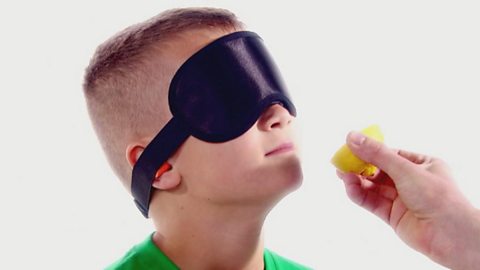
Why are ants different sizes? video
Dr George McGavin explains to the young scientists how the ant colony is organised into different types of ants, known as castes.
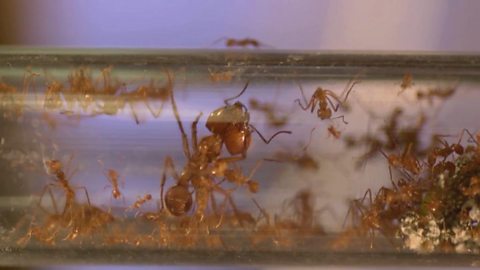
Life cycle of an ant. video
The young scientists learn about the life cycle of an ant, including how the eggs hatch into larvae.
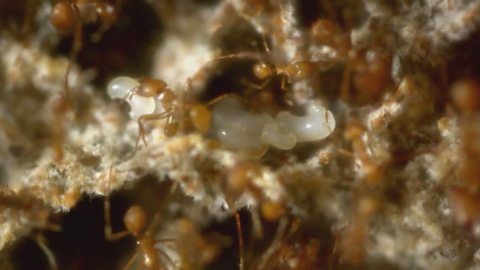
What ants eat and what eats ants. video
Young scientists draw lines connecting photos of different animals, according to whether they eat or are eaten by another animal.
